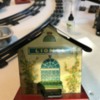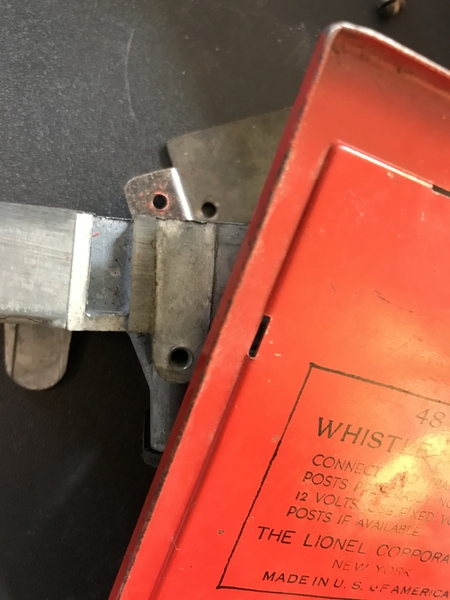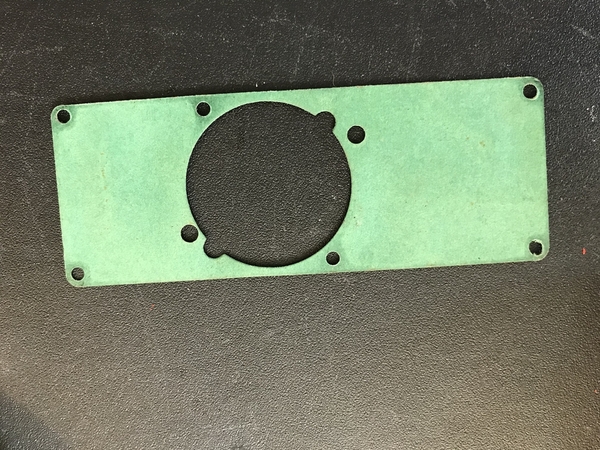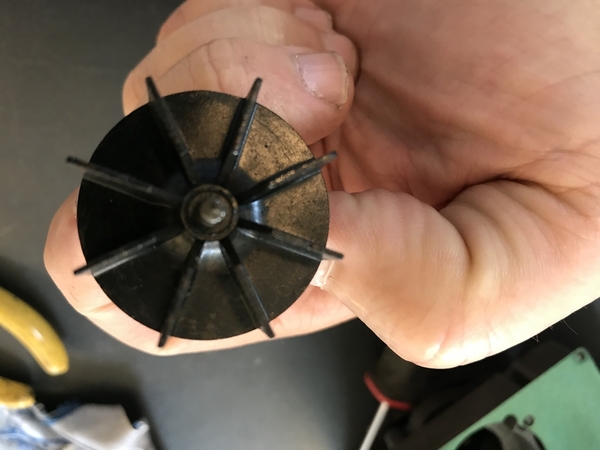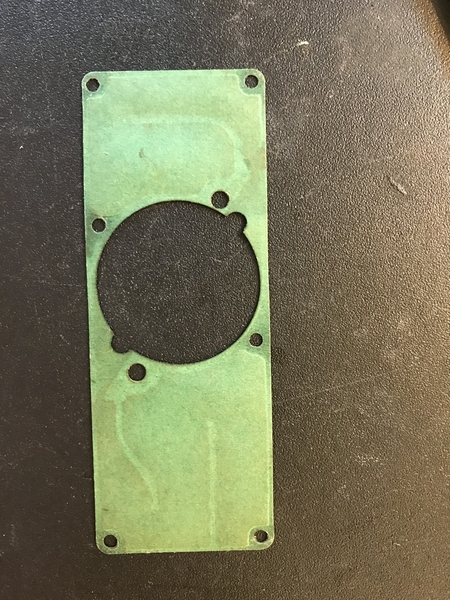I’ve been working on my old 48W and can’t seem to figure out how to get more air flow into the station to allow the whistle to sound. As you can see and hear in the video it’s okay with the roof off. However once the roof is back on it seems starved for air flow to allow the whistle to sound. The built in air passageway in the roof eves seem to be inadequate. Any ideas on how to improve the sound? I have a second housing in which someone had punched several nail holes into the side, which was an attempt for more air, I believe. Thanks in advance for your suggestions.
Replies sorted oldest to newest
Rich, did you get your 48W whistle fixed? I can tell you it has nothing to do with not enough air flow. There is plenty. Your whistle may need cleaning, oiling etc. I've had mine since about 1960. It has always had a problem a weak performance when I first turned it on, then works normal after has been used a little. Cleaning mine and oiling improved performance. Way back when, my father modified it a little by putting a nut between the contact, so the whistle is always connect. It's controlled by a push button with other train controls so one doesn't have to reach far to operate it.
Attachments
@Dch112 thanks for the interest, with the holidays approaching, shopping for grandkids presents and wrapping them all and family visiting the long answer is not yet. It’s on the top of my list right behind taking down all the Christmas decorations. I will post the working station video after I clean and lube.
Well Batmen riddle me this.
@bmoran4 I serviced the motor. The brushes were dirty and had even wear. Brushes had plenty of length with good springs. Cleaned the brushes and holder tubes. Commutator was dirty and was cleaned and polished and slots verified to be open.
Impeller was tight on the shaft. The bottom end armature shaft cup/bearing had some dry lube in it and that was cleaned out and lubed. Everything spins freely.
Bottom cover gasket was in place and plate on tight.
One question is that the brush plate oil well doesn’t have any wick material in it. Thought about a little cotton or a piece of a sponge. Cotten will probably bet wrapped around shaft and bind. Any thoughts on what a replacement material should be? Looked at a few part sites for replacement but didn’t see any.
@Dch112 I didn’t fix it at this point.
The 1st video is the unit working without the housing. Sounds promising.
The 2nd video is with the station enclosure around the whistle. Starting to get concerned.
The 3rd video is with the roof on and slid off. Now I’m puzzled.
If I cannot improve this performance my initial thoughts is to place it in the back of the table by the 120 tunnel without the enclosure out of sight. Possibly place it inside the 125 station. Again, without the enclosure however, I still would need to verify how it sounds. Each would require me to wire out a remote switch.
Any additional thoughts? This shouldn’t be this difficult so its a little frustrating.
Attachments
Sounds like you have made some progress, but looks like you will end up needing bushings/bearings to eliminate the growling rattle.
That's weird. It's almost like the acoustics in the building when the roof is on are eliminating the actual whistle part of the sound- the higher frequencies. I have been planning to add one of these to my prewar layout and wonder if anyone else has had this issue. I have never seen this mentioned.
Hopefully more people will weigh in.
For the life of me I can't figure out what the problem is with that whistle. I have one of these on my little all-tinplate layout and it works very well. The only thing I can think of is that there might be some kind of air leak around the whistle's housing which I guess could prevent the whistle from blowing with the roof on. Don't know why the whistle would react differently with the roof off though. An air leak is an air leak. For whatever its worth and probably not much but I have had whistle tenders with air leaks and they sounded like your 48W with the roof on. I sealed them with epoxy and then they sounded great. It might be worth checking into to. Good luck.
Since these are just copies of the Lionel Service documents, you have a few options:
1) Acquire an original set of binders with the service documents (somewhat difficult and expensive)
2) Acquire a compilation:
- Greenberg's Repair and Operating Manual for Lionel Trains, 1945-1969 (Greenberg's Repair and Operating Manuals)
- Complete Service Manual for Lionel Trains - Aurotech / K-Line
- http://www.hslinc.com/dahome/dalionelhome.html ( @John Holtmann 

3) Become a member of the LCCA - they have the whole HSL Library, including the service documents as a part of their digital library.
“One question is that the brush plate oil well doesn’t have any wick material in it. Thought about a little cotton or a piece of a sponge. Cotten will probably get wrapped around shaft and bind. Any thoughts on what a replacement material should be?”
On prewar equipment that little box was not an oil reservoir. It was identified as a “grease box”. You need to unbend the tabs and remove it from the brush plate. Clean out any old grease and refill it with a soft grease. Then reinstall it.
Most post war bearings are sintered bronze, so a oil filled felt wick against the outside of the bearing helps get lubrication to the inside of the bearing. Prewar bearings are machined high lead bronze. Applying lubrication to the outside of the bearing does nothing for lubricating the shaft. For lubrication Lionel put a small box of grease around the shaft at the end of the bearing to provide lubrication. Given how well the prewar equipment has held up, this lubrication method must be at least somewhat effective.
@Rich Wiemann posted:I’ve been working on my old 48W and can’t seem to figure out how to get more air flow into the station to allow the whistle to sound. As you can see and hear in the video it’s okay with the roof off. However once the roof is back on it seems starved for air flow to allow the whistle to sound. The built in air passageway in the roof eves seem to be inadequate. Any ideas on how to improve the sound? I have a second housing in which someone had punched several nail holes into the side, which was an attempt for more air, I believe. Thanks in advance for your suggestions.
Maybe it's just my old ears, but it sounds like one of the two whistle openings (ports) is not functioning at all. I would suggest taking the shell back off and check for air leaks by applying a long piece of painters tape (or any kind, this is just a test) around the whistle cover's perimeter to see if that makes a difference. Heck, I usually just wipe my finger around the cover seam while the motor is running - that has worked many times to reveal a leaky cover.
If that doesn't make any diff, pull the whistle and motor off the stand and examine the bottom port. Shake that thing to see what's inside your whistle chamber. You may have a spider's/rat's/wasp's next inside the whistle chamber - that would most certainly explain the weakness of the whistle and could easily explain why I'm only hearing one note of the two-tone whistle.
George
George @GeoPeg there’s nothing wrong with your hearing.
David @David Johnston there was some dried lubricant in the grease box which I removed and replaced.
Here’s what I’ve done.
I had ordered new brushes, springs and bottom bearing from Jeff Kane. Installed and made no difference. Verified there were no housing leaks and that there was good air flow out of both whistle ports.
Based upon George’s comment about only hearing a single tone I pursued that idea.
Here is a video of what I found....no tone from the bottom port.
Next I disassembled the whistle.
As you can see the housing was clear of any debris. Next I took measurements of the whistle port openings. The upper one measured 3/16” wide.
The bottom one measured 1/4” wide.
Inspection of the impeller and gasket looked good.
The end result was the same as the “as found” video. I can only assume that there may be a casting flaw/wear in the bottom port such that the air is blowing out and over the flute and is not producing a whistle sound due to its opening size or defect.
In the mean time I placed the second housing that I have which had nail holes punched in some of the windows. I drilled several holes in the upper eve area which are not visible with the roof on and that side is facing into the layout.
Here is the end result
Any additional ideas or pictures of whistle body castings would be appreciated. For now I will use it as is, the grandkids enjoy it anyways. I will be on the lookout for another body this October in York...hopefully.
Attachments
That is such a simple mechanism, yet can be so frustrating.
I know you said you checked for air leaks, but two things caught my attention; one is the missing chunks from the edge of the casting body near the lower port, If you haven't already done this, I still think it's worth a quick perimeter wrap of painters or masking tape along the whole perimeter, except of course for the whistle ports themselves. If there were multiple air leaks along the edge, it would be quite difficult to momentarily seal them all with your fingers., whereas the tape works great!
Number two: your gasket has a suspicious appearance - the dark areas show where it clearly sealed, yet there are areas along the outer edge and almost all of the internal edges (or walls of the resonating chambers) that show little or no sign of sealing. It's possible when reassembled (as it currently appears to be) a good, solid squeeze between the cover and the whistle body while the motor is running might suddenly produce that second tone you are looking for! If it is an internal leak, then your test for "housing leaks" (including the perimeter painter's tape) might not have revealed anything - but I would still do that step first to insure a good perimeter seal for the squeeze test.
If you've already done all this, well.... I'm officially out of ideas. Maybe the next step would be to hope for the best at York. Let's also hope there IS a York this year!
One, you could replace with a good sounding whistle unit from a gifting tender. Two, as with many items made of same metal, there could be some warpage, even if minor. The slightest amount of warp will be enough to disrupt the necessary airflow. Check trueness of the whistle casing with a metal straightedge and use tape, etc. to make up for any lose of contact to gasket.
Jesse TCA 12-68275
@GeoPeg and @texastrain
I made another attempt to get this working correctly based upon your suggestions, without much success.
1) Performed an air leak test with painters tape around the casing to cover seal. Also had a small section of tissue and checked for air movement around the gasket seal. There was no leakage seen with no improvement in the sound.
2) Inspected the gasket seating along the casing internals and outer edge. Here is a pic of the sealing outline. Looks like all the internal chambers are making contact.
3) The missing piece along the bottom edge is actually a smooth intentional section of the casting, from what I can see. This area is also sealed with the gasket.
4) Used a Starrett ruler and verified that the cover plate is flat. The top and bottom edges of the casting have depressions in them when the ruler is laid across the corner screw holes. Tried to place a strip of paper or thin cardboard to fill the gap. Neither attempt worked. When the center screw is tightened With just the gasket it pulled the cover in and seals so the upper whistle sounds.
Thanks for your interest and suggestions.
At this time its back on the layout for the grandkids to use with just the single tone. I guess I will be on the hunt for a donor tender.
Attachments
FYI. Several years ago I serviced some pre war whistles for a friend. Everything worked mechanically but the sound wasn't good. After looking at the old gaskets, I thought they looked just like some water color art paper(kinda thick and fiberous) . Got a small sheet from an art supply house, used a drill, wooden template, and exacto knife to copy the originals . One warped casting needed a double layer of gasket. Leak problem solved and sound improved dramatically! Those old heavy cast whistles set in a cast tender sound sooo good.
Steve




